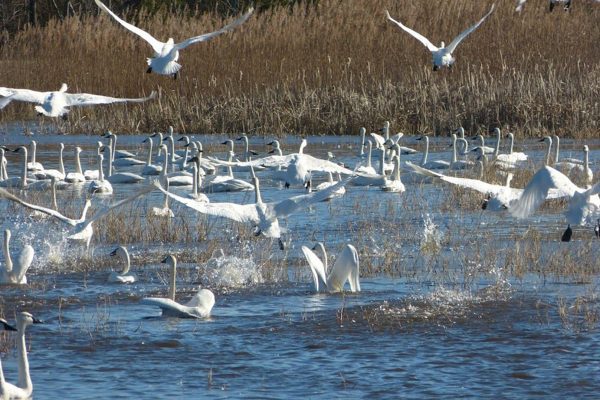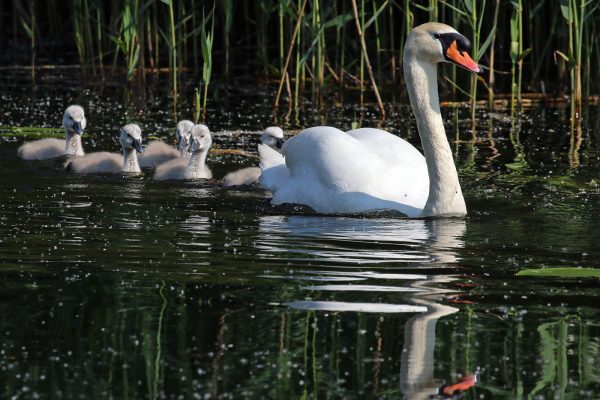For the last two weeks, Maine has been graced by one of the most graceful birds: a swan—in this case, a Tundra Swan.

Tundra Swans are rare in Maine, but one is currently visiting Sebasticook Lake in Newport. Shown, a flock of tundra swans in their normal wintering range along the coast of North Carolina. (Allie Stewart/USFWS)
Tundra Swans nest in the Arctic and sub-Arctic regions of Canada across to Alaska (there is also a Eurasian subspecies often referred to as Bewick’s swan). Birds nesting from the northern crown of Alaska eastward across northern Canada winter along the Atlantic Coast, usually from New York to the Carolinas. Birds nesting along the southwest coast of Alaska winter along the Pacific Coast and inland parts of the western U.S. They occasionally visit Maine.
Sebasticook Lake in Newport is playing host to our current Tundra Swan guest. After careful inspection, this particular swan has turned out to be an immature. It’s been staying put and delighting many birders who’ve made the trek for a look. Interestingly, there have been single immature Tundra Swans spotted about the same time in New Brunswick and way up in Goose Bay, Labrador. Tundra Swans are rare visitors in both of these places as well.
The Tundra Swan is one of two species of swan that are native to North America (the other being the Trumpeter Swan). A third (Mute Swan) was introduced from its Eurasian range and is now established. A fourth (Whooper Swan) is a rare visitor to Alaska and the West Coast, from Europe and Asia. All four have occurred in Maine, although the Whooper Swans that have been found here are all thought to have originated from escapes from captive waterfowl collections.
All four of these swans look pretty similar. The only distinguishing features are the color of the legs and bill, and various differences in the shape of the head, neck, and bill, most of which are often very subtle.
The very earliest written accounts of birds in Maine starting in the 1600s include mention of large, white swans. Back in those days, no one knew what the different types of swans were. Now we know that there were two possible species: Tundra Swans and Trumpeter Swans. Trumpeter Swans were thought to have nested across much of the northern U.S. and interior Canada to Alaska.
Unfortunately, from the earliest days of European colonization, swans were aggressively hunted as food and for their feathers. Because of this, they disappeared in many areas before Western science documented their range.

Mute Swans, introduced to the U.S. from Europe, have occasionally bred in southern Maine. Despite their demure appearance, they are often aggressive toward other waterfowl and to people who don’t respect their space. (Photo by Charles J. Sharp, courtesy of Wikimedia Commons.)
Mute Swans, their bills pointed down as they swim giving their necks a gentle curve, are the swan species probably familiar to most people. Despite their name, Mute Swans actually make a variety of sounds—grunts, hisses, and soft trumpeting vocalizations. And, although they may appear shy and demure, they can be quite aggressive toward other swans—and people who don’t respect their space. Mute Swans were kept by European nobles as a status symbol dating as far back as the Middle Ages. Today they are often seen at zoos, animal parks, farms, and other places. Mute Swans were first introduced into parts of the U.S. and Canada beginning in the late 1800s. Breeding populations didn’t become established largely until after the 1920s. Today, they occur along the Atlantic Coast from southern Maine (occasionally breeding) south to North Carolina and around the Great Lakes region, and in a restricted region of southern British Columbia.
It’s a little ironic that a snow-colored bird will likely disappear as winter snows descend upon Maine. But that is in fact the case. So if you want to see this rare visitor to Maine, take our advice and head out soon, before it heads off to warmer climes.
—Allison and Jeff Wells










Leave a Reply